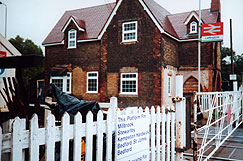
AM Midday PM
8:27 9:30 12:15 3:10 from Bletchley
Took approximately 50 minutes
Fares 1d per stop.
STATIONS IN 1846
London
Bletchley
Fenny Stratford
Woburn Sands
Ridgemont
Lidlington
Marston
Bedford
TRAIN STATIONS JUNE 1848
Bletchley
Fenny Stratford
Bow Brickhill
Woburn Sands
Aspley Guise
Husbourne Crawley
Ridgemont
Lidlington
Millbrook
Wootton Pillinge
Wootton Broadmead
Kempston Hardwick
Kempston
Bedford.
Bedford
Ampthill
Harlington
Leagrave
Luton
London.
First Railways
Bedford --> Bletchley railway Line
opened in 1846.
London + North Western railway
commenced
Mon 30/10/1846
Bletchley --> Bedford
Augmented by motor car service
One Class only.
An elaborate turf cutting ceremony was held on the 13th of December 1845 at Ridgemont. The Duchess of Bedford, held the spade that cut the turf. The line then took 11 months to complete. Line opened during November 1846. Delayed by landslides. Train had to climb 1:105 gradient of Brogborough Hill.
There were a number of crossing gates in the 16-mile journey - (15 in total). The Station Master's houses were built of pleasing 1/2 timbered design. They saved money by building low platforms at Millbrook, Lidlington and Ridgemont. No additional stations were built.
In October 1846, the line was inspected by the Board to Trade.The Board of Trade recommended that the line could open, but after bad weather, it actually opened on the 17th of November 1846.
It's report outlined the characteristics 16 miles of track, punctuated with stations, all having booking offices and accommodation for Station Masters or Clerks
Sixteen crossing located, all with gates that closed across roads. The Branch Line has used every type of gate that ever existed. Automatic barriers were installed in 1961 at the Marston Road Crossing (these were the second such set of gates installed in the Country by British Rail).
Bill Simpson Describes The Ceremony
All shops in Bedford closed, all towns people given a day off work to mark the occasion. At 12 o'clock 2 Bury engines pulled 33 carriages containing 600 passengers from Bedford to Bletchley. The journey took one and a half hours, 3 carriages were de-railed on a sharp bend, one hour from Bletchley Station. No one was hurt. Once at Bletchley, the train was turned on the 32-foot diameter turntable and returned to Bedford to a peel of Church bells and champagne reception, hosted by the Duchess of Bedfordshire. An evening reception for 200 guests was held at the Assembly Room.
Journey time to London was much faster and cost half the price of the stagecoach. New markets were opened up for local people to sell local produce; this reduced costs in agriculture and enabled a reverse flow of cheaper goods from urban producers to rural consumers.
Bill Simpson notes, that the railway did however; slow down road development because the stagecoach companies and turnpike trusts could not compete with such low costs and invariably went bankrupt.
Halts
The idea was to open halts to have motor trains serving all stations and halts. These halts were opened as follows:
Kempston and Elstow
Kempston Hardwick
Wootton Broadmead
Wootton Pillinge
Husbourne Crawley
Apsley Guise
Bow Brickhill.
Halts were at ground level so special coaches were constructed with fitted swivel steps to allow passengers to mount steps in this position. The brakes had to be fully applied and could not be released until steps fully folded back to the side of the coach. In 1939 - 1945 war forced closure of Kempston and Elstow, Wootton Boradmead and Husbourne Crawley. These halts were closed and never re-opened. Wootton Pillinge was renamed Stewartby in 1935.
Policemen used to stop road traffic using a frock and top hat. Signalmen have now replaced policemen for over one hundred years, but are still referred to as "bobbies".
Lidlington Station
The least interesting of the stations, used solely for picking up and dropping off passengers. The Station House was unlike most other Station Houses at the time, because it was totally brick built, of yellow gault bricks with red brick dressing and ornamental roof tiles. There are no sidings at Lidlington, because of good storage facilities at Millbrook.The 1930's opening of Marston Brick Valley Company, meant several sidings were built at the Marston Road Crossing. At one time, there was a large enough migrant work force at the brickworks that signs and signals at Marston Road were displaced in Italian.


Flying Scotsman
The Flying Scotsman passed through Lidlington Station in the early hours of the morning of the 30th of March 1974.
R101
Several 2 funnel trains carried the victims of the R101 airship disaster in October 1930. During this, all shops were closed and houses in view of the station were asked to close all their curtains as a mark of respect. The Lidlington British Legion stood on the platform
Death on the Line
There was a death of the railway line on Saturday the 22nd of July 1882 at 9:36pm. A girl named Susan Garrett, aged 14, and went to meet the sister of Mrs Pearce. She crossed the line in front of the pilot engine and the engine buffer caught the girl in the face, and killed her immediately. She is buried in Lidlington Church.
